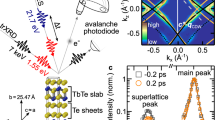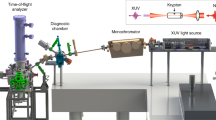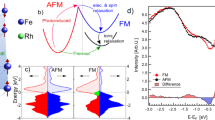Abstract
Intense femtosecond (10−15 s) light pulses can be used to transform electronic, magnetic and structural order in condensed-matter systems on timescales of electronic and atomic motion1,2,3. This technique is particularly useful in the study4,5 and in the control6 of materials whose physical properties are governed by the interactions between multiple degrees of freedom. Time- and angle-resolved photoemission spectroscopy is in this context a direct and comprehensive, energy- and momentum-selective probe of the ultrafast processes that couple to the electronic degrees of freedom7,8,9,10. Previously, the capability of such studies to access electron momentum space away from zero momentum was, however, restricted owing to limitations of the available probing photon energy10,11. Here, using femtosecond extreme-ultraviolet pulses delivered by a high-harmonic-generation source, we use time- and angle-resolved photoemission spectroscopy to measure the photoinduced vaporization of a charge-ordered state in the potential excitonic insulator 1T-TiSe2 (refs 12, 13). By way of stroboscopic imaging of electronic band dispersions at large momentum, in the vicinity of the edge of the first Brillouin zone, we reveal that the collapse of atomic-scale periodic long-range order happens on a timescale as short as 20 femtoseconds. The surprisingly fast response of the system is assigned to screening by the transient generation of free charge carriers. Similar screening scenarios are likely to be relevant in other photoinduced solid-state transitions and may generally determine the response times. Moreover, as electron states with large momenta govern fundamental electronic properties in condensed matter systems14, we anticipate that the experimental advance represented by the present study will be useful to study the ultrafast dynamics and microscopic mechanisms of electronic phenomena in a wide range of materials.
This is a preview of subscription content, access via your institution
Access options
Subscribe to this journal
Receive 51 print issues and online access
$199.00 per year
only $3.90 per issue
Buy this article
- Purchase on Springer Link
- Instant access to full article PDF
Prices may be subject to local taxes which are calculated during checkout



Similar content being viewed by others
References
Yonemitsu, K. & Nasu, K. Theory of photoinduced phase transitions in itinerant electron systems. Phys. Rep. 465, 1–60 (2008)
Bargheer, M., Zhavoronkov, N., Woerner, M. & Elsaesser, T. Recent progress in ultrafast X-ray diffraction. ChemPhysChem 7, 783–792 (2006)
Bigot, J.-Y., Vomir, M. & Beaurepaire, E. Coherent ultrafast magnetism induced by femtosecond laser pulses. Nature Phys. 5, 515–520 (2009)
Chollet, M. et al. Gigantic photoresponse in ¼-filled-band organic salt (EDO-TTF)2PF6 . Science 307, 86–89 (2005)
Demsar, J., Biljakovic´, K. & Mihailovic, D. Single particle and collective excitations in the one-dimensional charge density wave solid K0. 3MoO3 probed in real time by femtosecond spectroscopy. Phys. Rev. Lett. 83, 800–803 (1999)
Rini, M. et al. Control of the electronic phase of a manganite by mode-selective vibrational excitation. Nature 449, 72–74 (2007)
Haight, R. & Silbermann, J. A. Surface intervalley scattering on GaAs(110): direct observation with picosecond laser photoemission. Phys. Rev. Lett. 62, 815–818 (1989)
Fann, W. S., Storz, R., Tom, H. W. K. & Bokor, J. Electron thermalization in gold. Phys. Rev. B 46, 13592–13595 (1992)
Bauer, M. et al. Direct observation of surface chemistry using ultrafast soft-X-ray pulses. Phys. Rev. Lett. 87, 025501 (2001)
Perfetti, L. et al. Time evolution of the electronic structure of 1T-TaS2 through the insulator-metal transition. Phys. Rev. Lett. 97, 067402 (2006)
Schmitt, F. et al. Transient electronic structure and melting of a charge density wave in TbTe3 . Science 321, 1649–1652 (2008)
Cercellier, H. et al. Evidence for an excitonic insulator phase in 1T-TiSe2 . Phys. Rev. Lett. 99, 146403 (2007)
Di Salvo, F. J., Moncton, D. E. & Waszczak, J. V. Electronic properties and superlattice formation in the semimetal TiSe2 . Phys. Rev. B 14, 4321–4328 (1976)
Ashcroft, N. W. & Mermin, N. D. Solid State Physics (Brooks/Cole, Belmont, 1976)
Ohta, T., Bostwick, A., Seyller, T., Horn, K. & Rotenberg, E. Controlling the electronic structure of bilayer graphene. Science 313, 951–954 (2006)
Kondo, T., Khasanov, R., Takeuchi, T., Schmalian, J. & Kaminski, A. Competition between the pseudogap and superconductivity in the high-T c copper oxides. Nature 457, 296–300 (2009)
Mazin, I. Superconductivity gets an iron boost. Nature 464, 183–186 (2010)
Rossnagel, K., Kipp, L. & Skibowski, M. Charge-density-wave phase transition in 1T-TiSe2: excitonic insulator versus band-type Jahn-Teller mechanism. Phys. Rev. B 65, 235101 (2002)
Kidd, T. E., Miller, T., Chou, M. Y. & Chiang, T.-C. Electron-hole coupling and the charge density wave transition in TiSe2 . Phys. Rev. Lett. 88, 226402 (2002)
Rundquist, A. et al. Phase matching of soft-X-ray harmonic emission in hollow-core fibers. Science 280, 1412–1415 (1998)
Anisimov, S. I., Kapeliovich, B. L. & Perel’man, T. L. Electron-emission from surface of metals induced by ultrashort laser pulses. Sov. Phys. JETP 39, 375–377 (1974)
Cavalleri, A. et al. Evidence for a structurally-driven insulator-to-metal transition in VO2: a view from the ultrafast timescale. Phys. Rev. B 70, 161102(R) (2004)
Wall, S. et al. Quantum interference between charge excitation paths in a solid-state Mott insulator. Nature Phys. advance online publication. 10.1038/nphys1831 (5 December 2010)
Holy, J. A., Woo, K. C., Klein, M. V. & Brown, F. C. Raman and infrared studies of superlattice formation in TiSe2 . Phys. Rev. B 16, 3628–3637 (1977)
El Sayed, K., Schuster, S., Haug, H., Herzel, F. & Henneberger, K. Subpicosecond plasmon response: buildup of screening. Phys. Rev. B 49, 7337–7344 (1994)
Bányai, L., Vu, Q. T., Mieck, B. & Haug, H. Ultrafast quantum kinetics of time-dependent RPA-screened Coulomb scattering. Phys. Rev. Lett. 81, 882–885 (1998)
Huber, R. et al. How many-particle interactions develop after ultrafast excitation of an electron-hole plasma. Nature 414, 286–289 (2001)
Sokolowski-Tinten, K. et al. Femtosecond X-ray measurement of coherent lattice vibrations near the Lindemann stability limit. Nature 422, 287–289 (2003)
Siwick, B. J., Dwyer, J. R., Jordan, R. E. & Miller, R. J. D. An atomic-level view of melting using femtosecond electron diffraction. Science 302, 1382–1385 (2003)
Miaja-Avila, L. et al. Laser-assisted photoelectric effect from surfaces. Phys. Rev. Lett. 97, 113604 (2006)
Acknowledgements
M.B. and S.M. thank M. Aeschlimann for support and discussion. M.B. and S.M. also thank M. Murnane and H. Kapteyn for their support through the NSF EUV ERC. A.C. acknowledges support from the JILA Physics Frontier Center. This work was supported by the German Science Foundation (DFG) within the SFB 855 (C.S., M.B., L.K., K.R.) and by the European Community's FP7 under Marie Curie International Outgoing Fellowship GA 253316 (S.M.). Operation of the Advanced Light Source is supported by the US Department of Energy, Office of Basic Energy Sciences.
Author information
Authors and Affiliations
Contributions
M.B. and K.R. conceived the experiment and wrote the paper. T.R., S.H., M.W., B.S., S.M., L.K., M.B. and K.R. realized the experimental time-resolved ARPES setup. A.C., L.M.A. and Y.L. designed and fabricated the EUV multilayer mirrors. T.R., S.H., M.W., C.S. and A.S. collected the time-resolved photoemission data and performed the data analysis. M.K. and K.R. collected and analysed the static photoemission data at the Advanced Light Source. All authors discussed the results and commented on the manuscript.
Corresponding authors
Ethics declarations
Competing interests
The authors declare no competing financial interests.
Supplementary information
Supplementary Information
The file contains Supplementary Text, Supplementary Figures 1-5 with legends and additional references. (PDF 911 kb)
Supplementary Movie 1
The movie shows photo-induced phase transition (see Supplementary Information S1 for full legend). (MOV 5118 kb)
Rights and permissions
About this article
Cite this article
Rohwer, T., Hellmann, S., Wiesenmayer, M. et al. Collapse of long-range charge order tracked by time-resolved photoemission at high momenta. Nature 471, 490–493 (2011). https://doi.org/10.1038/nature09829
Received:
Accepted:
Published:
Issue Date:
DOI: https://doi.org/10.1038/nature09829
This article is cited by
-
Spot the defects
Nature Physics (2024)
-
Photoexcitation induced magnetic phase transition and spin dynamics in antiferromagnetic MnPS3 monolayer
npj Computational Materials (2023)
-
Signatures of the exciton gas phase and its condensation in monolayer 1T-ZrTe2
Nature Communications (2023)
-
Light-induced hexatic state in a layered quantum material
Nature Materials (2023)
-
Superconductivity induced by gate-driven hydrogen intercalation in the charge-density-wave compound 1T-TiSe2
Communications Physics (2023)
Comments
By submitting a comment you agree to abide by our Terms and Community Guidelines. If you find something abusive or that does not comply with our terms or guidelines please flag it as inappropriate.



